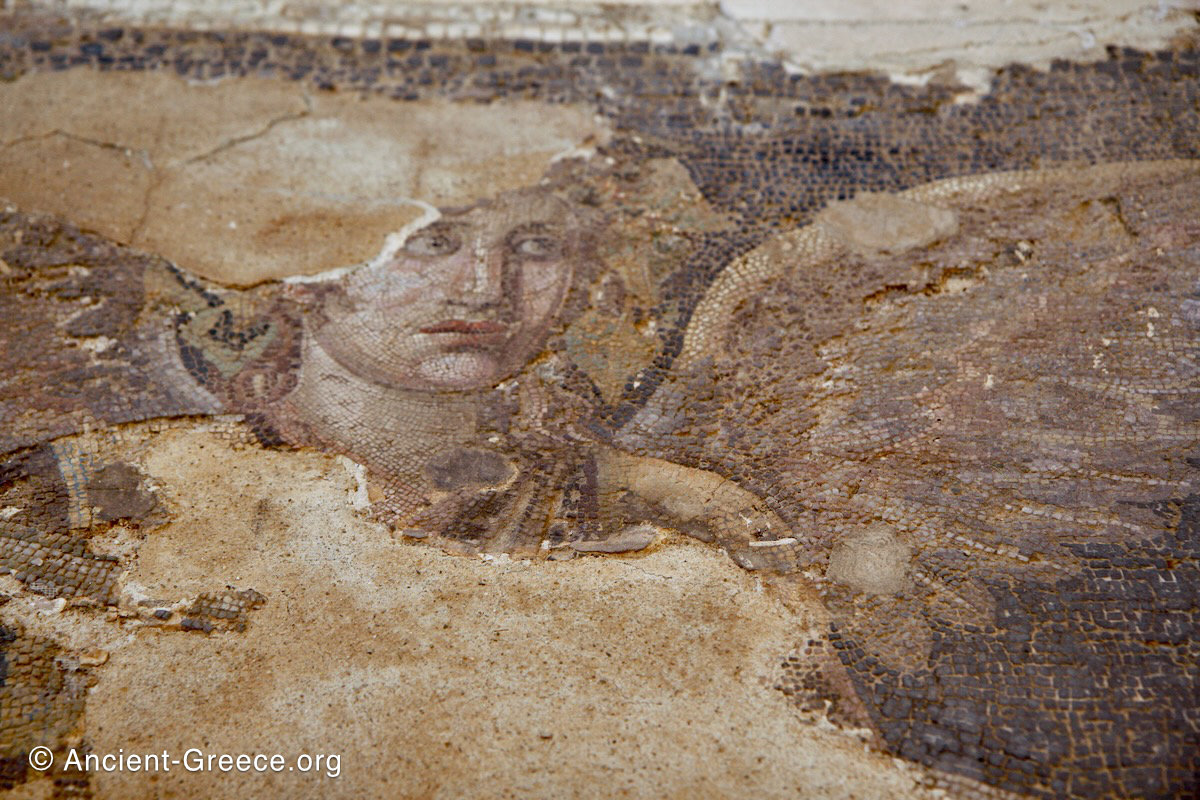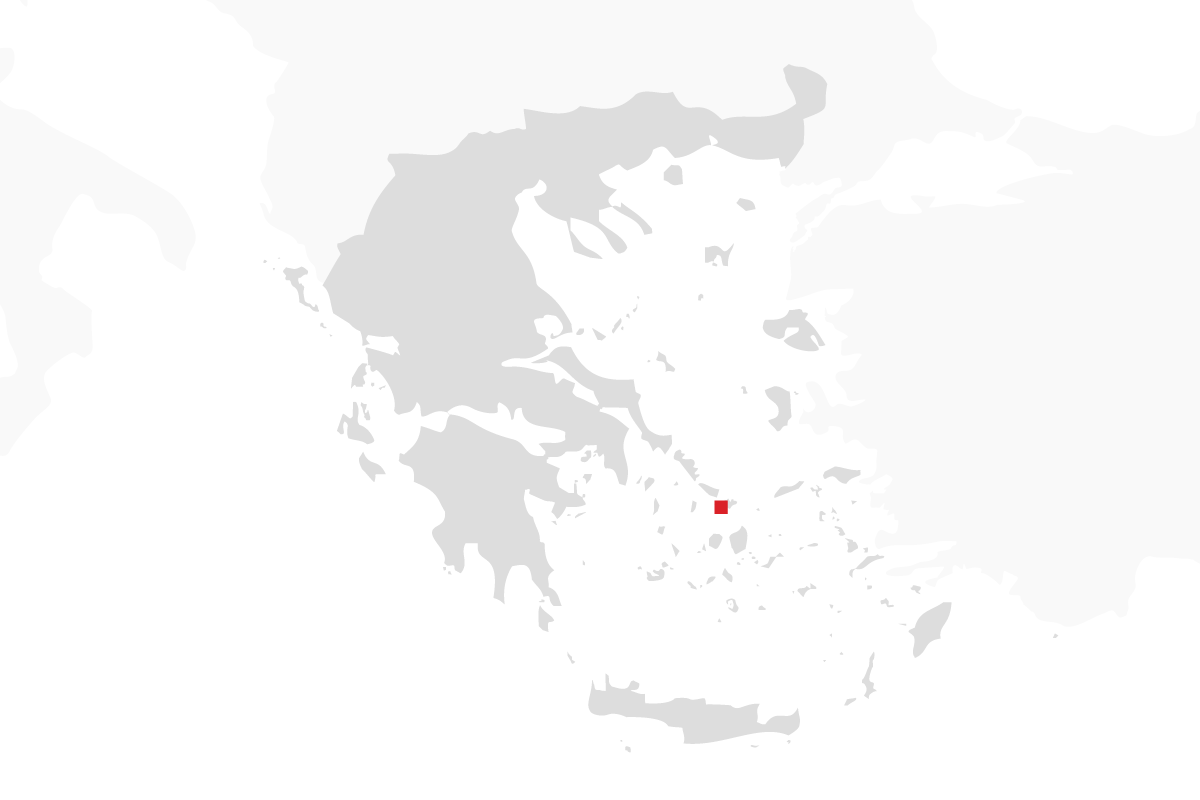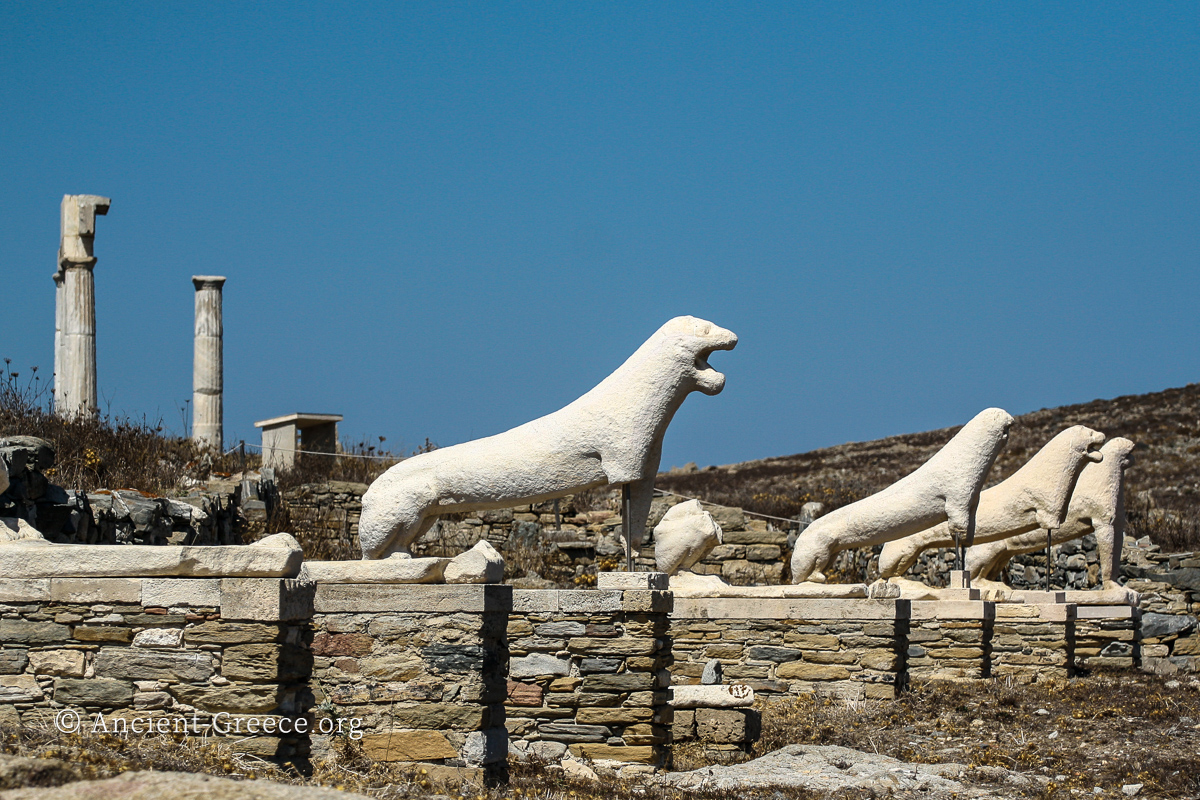
On this page:
The small archaeological museum located in the archaeological site of Delos and exhibits objects from the excavations that still take place on the island.
Just like the archaeological site, it is accessible only by shuttle boat from nearby Mykonos island.
Mosaics and Frescoes
Top row, left to right:
- Mosaic detail: face of Dionysos. From the House of Dionysos mosaic floor.
- Mosaic detail: face of the tiger. From the House of Dionysos mosaic floor.
Second row:
- Part of the mosaic from the House of Dionysos. The god appears with outstretched wings, riding a tiger that wears a necklace of vines and grapes around its neck.
- Mosaic floor from the Scardana Quarter.
The central panel depicts Athena on the left holding a spear and her owl, and opposite her stands Hermes holding the caduceus. Between them, a female figure sits with an infant on her knees. It probably represents Hermes bringing infant Dionysus to the Nymphs. The border depicts bull-heads and theatrical masks among floral motifs. - Scardana Quarter mosaic detail: Athena.
- Scardana Quarter mosaic detail: Hermes.
- Mosaic.
Mosaic and fresco details.
Archaic Sculpture
Top row, left to right:
- Statue of a sphinx on an ionic capital. Parian work, middle of 6th c. BCE.
- Upper half of a kouros from the Sanctuary of Apollo. Naxian work, 2nd quarter of 6th c. BCE.
- Upper part of a kouros. Naxian work, 3rd quarter of 7th c. BCE.
- Horseman. Second half of the 6th c. BCE
Second row:
- Statues of enthroned Hera from the Heraion. End of 6th c. BCE.
Third row:
- Statue of a woman wearing the peplos. From the Sanctuary of Apollo. Parian work. 580 BCE.
- Torso of a kouros from the Sanctuary of Apollo. Naxian work, middle of the 6th c. BCE.
- Side view of kouros from the Sanctuary of Apollo. Middle of the 6th c. BCE.
- Torso of a kouros. Naxian work. Middle of the 6th c. BCE.
Top row, left to right:
- Kore statue. 6th c. BCE.
- Kore from the Artemision.Parian work, ca. 500 BCE.
- Part of a kouros from the Sanctuary of Apollo. Naxian work. Late 7th cent. BCE.
- Torso of a kouros from the Sanctuary of Apollo. Middle of the 6th c. BCE.
Second row:
- Torso of a kouros, Naxian work. Mid-6th c. BCE.
- Torso of a kore. Parian work. Late 6th c. BCE.
- Kouros. Parian work, 3d quarter of 6th c. BCE.
- Gable of an altar. Late 5th c. BCE.
Bottom row:
- Kouros statue base with inscription in Ancient Greek. 2nd half of 7th c. BCE.
The inscription reads “Ευθυαρτίδης μανέθεκεν ο Νάξιοσ ποιήσας” (“I was made and dedicated by the Naxian Euthykartides”) - Left hand fragment of the colossal statue of Apollo (Colossus of the Nations). Circa 600 BCE.
- Statue of a lion from the Artemision. Parian work. circa 500 BCE.
- The original lion sculptures from the Terrace of the Lions are protected from the elements in the Delos Archaeological Museum. Exact replicas stand in their place on the archaeological site.
The statues of the lions were dedicated to the sanctuary of Apollo at the end of the 7th c. or early in the 6th c. BCE. They stood as guardians of the Sacred Lake and the sanctuary. The original number of lions ranges between nine and nineteen.
Classical and Post-Classical Sculpture
Top row, left to right:
- Statue of Artemis and a deer. From the Theatre Quarter. Late 2nd c. BCE.
- Statue of a Nymph. Copy of a 4th c. original. From the House of Herm.
Second row:
- Female statuette. Found west of the Agora of Thophrastos. Circa 430 BCE.
- Female mantle statue in the Herculaneum woman type made popular by Praxiteles. From the Agora of Theophrastus. 2nd c. BCE.
- Statue of a Nymph running. From the corner acroterion of the temple of the Athenians. Late 5th c. BCE.
- Aphrodite of the Praxitelian type. From the Establishment of the Poseidoniasts.
- Statue of a Nymph (probably Amymone) from a group of statues that included Poseidon. From the Establishment of the Poseidoniasts.
Third row:
- Hellenistic terracotta statuette of Aphrodite.
- Four female statuettes.
Chryselephantine (gold and ivory) statue fragments from the Archaic Era.
Top row, left to right:
- Torso of a discus-thrower. Parian work, 2nd quarter of 5th cent. B.C
- Back view of torso of a discus-thrower.
- Statue of Gaius Ofellius Ferus dedicated to Apollo. Back view. Found in the Agora of the Italians, 125–100 BC. BCE.
- Statues from the east pediment apex of the Temple of the Athenians. It depicts Boreas, the Thracian King who personified the northern wind, abducts Oreithyia.
- Female head.
Second row:
- Head of a colossal statue of Demetrios Poliorcetes. From the Dodecatheon. 3d c. BCE.
- Statue of an actor dressed as Papposilenus in sheepskin and himation. A typical statue associated with Dionysus. From the Stoibadeion. 2nd c. BCE.
- Statue of a youth similar to Praxiteles’ Satyr type. From the NW corner of the Agora of the Italians.
- Statue of Apollo. From the House of Masks.
- Torso of a wrestler. 2nd quarter 5th c. BCE.
- Statue of Dionysos from the Stoibadeion.
Chryselephantine (gold and ivory) statue fragments from the Archaic Era.
Top row, left to right:
- The original statues of Kleopatra and Dioskourides. The statues that appear outdoors in the archaeological site are replicas.
- Grave stele. Late 2nd c. BCE.
- Marble stele with bronze relief sculpture. From the sanctuary of Agathe Tyche. Late 3d c. BCE.
- Bronze relief. Part of a marble stele. It shows Artemis preparing for a sacrifice aided by two satyrs. From the sanctuary of Agathe Tyche. Late 3d c. BCE.
- Torso of a Roman general. From the Monument of Mithridates. Early 1st c. BCE.
- Head of Hermes from the House of Herm. Early 1st c. BCE.
Second row:
- Herm of Priapos statue.
- A collection of phallic sculptures and erotic-themed statuettes. Phallic sculptures and Herms had apotropaic qualities and were used widely in ancient Greece. Some have humorous inscriptions inscribed on them.

















































































